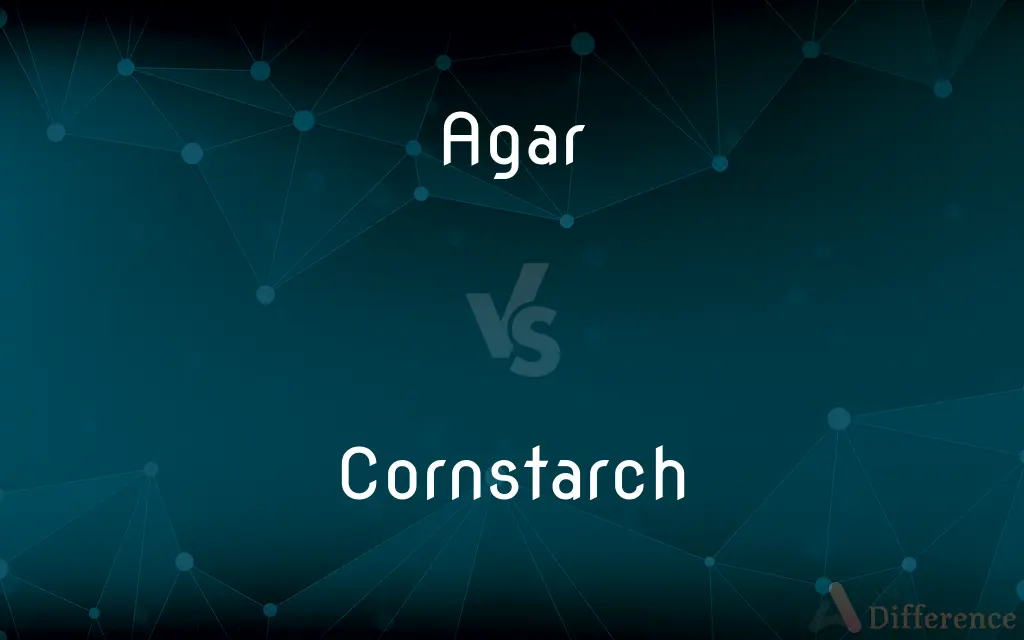Agar vs. Cornstarch — What's the Difference?
Edited by Tayyaba Rehman — By Urooj Arif — Updated on March 29, 2024
Agar is a gelatinous substance derived from algae, used in culinary and lab settings, whereas cornstarch is a carbohydrate extracted from corn, used as a thickening agent in cooking.

Difference Between Agar and Cornstarch
Table of Contents
ADVERTISEMENT
Key Differences
Agar, extracted from seaweed, serves as a vegan gelatin substitute in foods and as a culture medium in microbiology. It sets firmer than gelatin and remains solid at room temperature. Whereas cornstarch, a fine powder made from corn kernels, is primarily used to thicken sauces, soups, and gravies. It requires heating to activate its thickening properties and achieves a smooth texture.
While agar is celebrated for its ability to create firm, jelly-like textures in dishes and does not require refrigeration to set, cornstarch is known for its neutral flavor and ability to thicken liquids without altering their taste. Agar's setting properties are activated upon boiling, then cooling, while cornstarch thickens at a lower temperature and needs careful handling to avoid lumpiness.
Agar is rich in fiber and has minimal calories, making it a popular choice for dietary supplements and weight loss aids. On the other hand, cornstarch is high in calories and carbohydrates, offering a quick source of energy but lacking significant nutritional benefits.
In the culinary world, agar is versatile, used in making desserts, aspic, and as a stabilizer in some dairy products. Cornstarch finds its place in creating velvety sauces, thickening fillings for pies, and in baking, providing a tender texture to cakes and cookies.
The use of agar extends beyond the kitchen; it's crucial in scientific research as a culture medium for bacteria and fungi. This application showcases its inertness and suitability for growing microorganisms, a property not shared by cornstarch. Cornstarch, however, is integral in home and industrial settings, used in products from biodegradable plastics to adhesives.
ADVERTISEMENT
Comparison Chart
Source
Seaweed
Corn kernels
Primary Use
Gelatin substitute, culture medium
Thickening agent
Setting Properties
Sets firm, solid at room temperature
Thickens with heat, smooth texture
Nutritional Value
High in fiber, low in calories
High in calories and carbs
Culinary Application
Desserts, jellies, dairy stabilizer
Sauces, soups, gravies, baking
Non-Culinary Uses
Microbiology culture medium
Biodegradable products, adhesives
Compare with Definitions
Agar
Used as a solidifying agent in cooking and baking.
Agar added firmness to the vegan cheesecake.
Cornstarch
Used in baking to soften the texture of cakes and pastries.
Adding cornstarch to cake batter results in a tender crumb.
Agar
A gelatinous substance derived from algae.
Agar is used to make a vegan version of gelatin desserts.
Cornstarch
Integral to creating smooth sauces and soups.
A slurry of cornstarch and water thickens sauces without altering their taste.
Agar
A dietary supplement due to its high fiber content.
Agar is included in dietary plans for its satiating properties.
Cornstarch
A thickening agent derived from corn.
Cornstarch is used to thicken gravy for a silky-smooth consistency.
Agar
Found in various health food products.
Agar is a key ingredient in some vegan dairy substitutes.
Cornstarch
Acts as an anti-caking agent in powdered sugar.
Cornstarch prevents powdered sugar from clumping.
Agar
Acts as a culture medium in microbiological work.
Scientists use agar plates to grow bacteria cultures.
Cornstarch
Utilized in the manufacturing of biodegradable plastics.
Cornstarch is a component in eco-friendly packaging materials.
Agar
Agar ( or ), or agar-agar, is a jelly-like substance obtained from red algae.Agar is a mixture of two components: the linear polysaccharide agarose and a heterogeneous mixture of smaller molecules called agaropectin. It forms the supporting structure in the cell walls of certain species of algae and is released on boiling.
Cornstarch
Finely ground maize flour, used as a thickener in cooking; cornflour.
Agar
A gelatinous substance obtained from certain red seaweeds and used in biological culture media and as a thickener in foods.
Cornstarch
Starch prepared from corn grains, used industrially and as a thickener in cooking.
Agar
A gelatinous material derived from certain marine algae. It is used as a base for bacterial culture media and as a stabilizer and thickener in many food products.
Cornstarch
A very fine starch powder derived from corn (maize) used in cooking as a thickener, to keep things from sticking, or as an anti-caking agent.
Agar
A culture medium containing this material.
Cornstarch
Starch made from Indian corn, esp. a fine white flour used for puddings, etc.
Agar
A gelatinous material obtained from red algae, especially Gracilaria species, used as a bacterial culture medium, in electrophoresis and as a food additive.
Cornstarch
Starch prepared from the grains of corn; used in cooking as a thickener
Agar
A culture medium based on this material.
Agar
Agarwood
Agar
Common shortened form of agar-agar{2}.
Agar
Any culture medium that uses agar as the gelling agent; - used especially with a modifying prefix, as, EMB agar. The term is applied both to the dehydrated medium powder containing agar and to the gelatinous medium prepared from it.
Agar
Any culture medium that uses agar as the gelling agent
Agar
A colloidal extract of algae; used especially in culture media and as a gelling agent in foods
Common Curiosities
How do you activate the thickening properties of cornstarch?
By mixing it with cold water to form a slurry and then heating it in a liquid.
Can cornstarch be used in making jelly-like desserts?
While cornstarch can thicken to a gel-like consistency, it doesn't set firm like agar-based jellies.
How does agar affect the texture of desserts compared to cornstarch?
Agar results in a firmer, more gelatinous texture, while cornstarch provides a smooth, creamy consistency.
Can agar and cornstarch be used interchangeably?
No, they serve different purposes; agar is used for setting and gelling, whereas cornstarch is for thickening liquids.
How do you dissolve agar for culinary uses?
Agar needs to be boiled in liquid for a few minutes to fully dissolve and activate its gelling properties.
Is agar vegan?
Yes, agar is vegan as it is derived from seaweed.
Are there any health benefits to using cornstarch?
Cornstarch is mainly a source of calories and lacks significant nutritional benefits.
Is agar beneficial for weight loss?
Yes, agar is low in calories and high in fiber, which can promote satiety and aid in weight loss.
How do agar and cornstarch impact the flavor of dishes?
Agar is flavorless and doesn't affect the taste of dishes, while cornstarch is also neutral but can dilute flavors if overused.
What is the main difference between agar and cornstarch?
Agar is derived from seaweed and used as a vegan gelatin substitute, while cornstarch is a thickening agent from corn.
Can cornstarch be used in microbiology?
No, cornstarch is not suitable as a culture medium like agar.
What are the limitations of using cornstarch in recipes?
Overheating or excessive stirring after thickening can break down cornstarch, resulting in a thinner consistency.
Can agar be used in all the same applications as gelatin?
While agar is a great gelatin substitute, it sets much firmer than gelatin, so adjustments may be necessary for certain recipes.
Why is agar preferred in vegan cooking?
Because it serves as a plant-based alternative to gelatin, aligning with vegan dietary restrictions.
Is it possible to substitute cornstarch for agar in a recipe?
Due to their different properties and uses, substituting one for the other may not yield the desired results in most recipes.
Share Your Discovery

Previous Comparison
Collateral vs. Deposit
Next Comparison
Narrative vs. PlotAuthor Spotlight
Written by
Urooj ArifUrooj is a skilled content writer at Ask Difference, known for her exceptional ability to simplify complex topics into engaging and informative content. With a passion for research and a flair for clear, concise writing, she consistently delivers articles that resonate with our diverse audience.
Edited by
Tayyaba RehmanTayyaba Rehman is a distinguished writer, currently serving as a primary contributor to askdifference.com. As a researcher in semantics and etymology, Tayyaba's passion for the complexity of languages and their distinctions has found a perfect home on the platform. Tayyaba delves into the intricacies of language, distinguishing between commonly confused words and phrases, thereby providing clarity for readers worldwide.














































